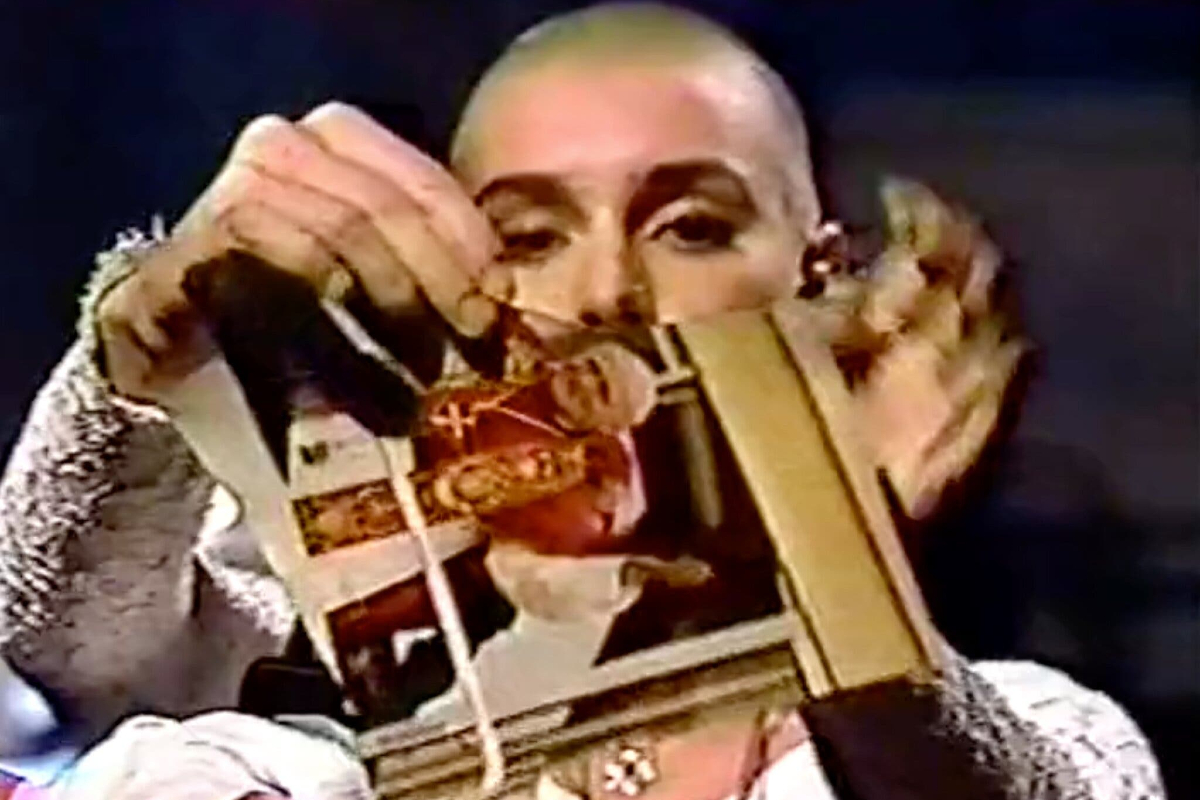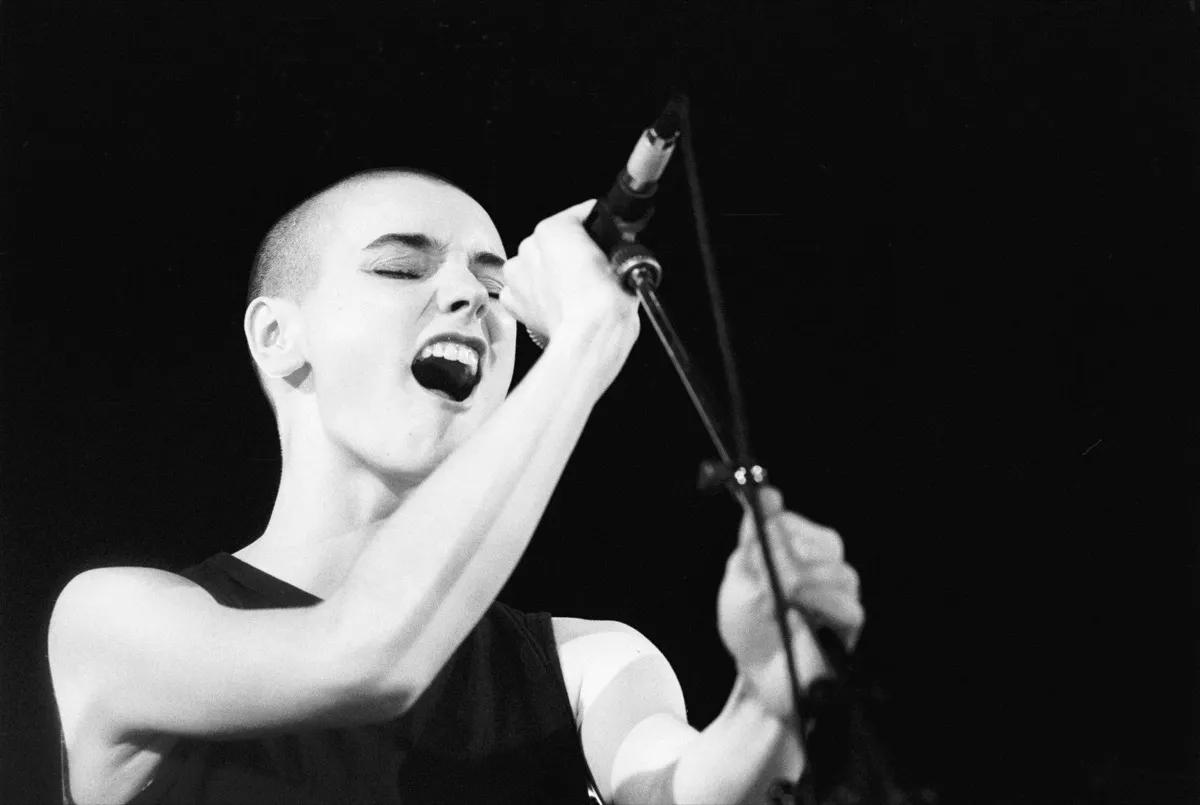Sinéad O’Connor has died. Long live Sinéad O’Connor.
If you’re a ’90s kid like me, you probably didn’t hear much about Sinéad O’Connor. I first heard of her when I was a child, after my Catholic parents saw her ripping up a picture of the pope on Saturday Night Live. I was told it was a “bad thing” for her to do, and I quickly forgot about her. As it turns out, so did the rest of the world.
As I got older and distanced myself from the Catholic Church, I rediscovered Sinéad O’Connor’s music and her legacy of rebellion. While many criticized her decision to destroy an image of the pope on live TV, no one seemed to care about why she did it. At that point in history, the Catholic Church had been implicated in thousands of cases of child sexual abuse perpetrated by clergy; Pope John Paul II, the acting pope at the time, allegedly knew about them. Sinéad O’Connor tore the picture—once owned by her mother—in an act of protest against not only the Catholic church, but abusers and liars everywhere.
The audience was not sympathetic. NBC received thousands of calls from outraged viewers across America. On the next SNL episode, host Joe Pesci said that if he were in the room during Sinéad’s protest, he would have given her “such a smack”. She was effectively blacklisted by the industry, and her career was reportedly ruined. According to O’Connor herself, however, her act of protest was the one thing that saved it.

When asked in an interview if the decision ruined her career, she said, “Yes, in a beautiful fucking way. There was no doubt about who this bitch is. There was no more mistaking this woman for a pop star … people say, ‘Oh, you fucked up your career’ but they’re talking about the career they had in mind for me. I fucked up the house in Antigua that the record company dudes wanted to buy. I fucked up their career, not mine.”
This was far from the first time that Sinéad O’Connor repudiated major labels. O’Connor told Rolling Stone in 1991 that record label Ensign wanted her to wear tight jeans and high-heel boots and grow out her hair. “I decided that they were so pathetic,” she said, “that I shaved my head.”
Despite her antipathy for the trappings of pop stardom, O’Connor tirelessly supported artists who were left out of the music industry. She was one of the first white artists to support the growing hip hop genre in the 1980s, featuring rapper MC Lyte on her song “I Want Your (Hands On Me)” and giving him full credit. As author Dart Adams points out, she even posed with MC Lyte on the cover of the 12″ record and gave him equal billing, a rarity for rock artists in those days.
O’Connor’s support for Black artists did not go unnoticed. After her death, Chuck D of the seminal hip hop act Public Enemy honored her in a Twitter post. When Chuck D and the rest of Public Enemy protested the 1989 Grammy Awards for refusing to recognize rap music, Sinéad O’Connor performed with the Public Enemy logo painted on the side of her head to raise awareness of the group’s stance.
In 1991, O’Connor and Public Enemy boycotted the Grammys altogether in protest of America’s decision to enter into the Gulf War, as Rolling Stone noted in its obituary.
Sinéad O’Connor did not reach true superstardom until she covered Prince’s “Nothing Compares 2 U,” arguably her most famous song to date. While Prince praised O’Connor’s cover in public, her success allegedly infuriated him in private. The singer responded by inviting O’Connor to his estate and—according to O’Connor—proceeded to assault her. He allegedly challenged her to a pillow fight, using the playful invitation as a ploy beat her with a “hard object” concealed inside the pillow. When O’Connor tried to leave his mansion, Prince physically blocked her path and tried to force her into his car. O’Connor fled on foot and frantically rang the doorbell of a neighbor in order to escape. At that point, Prince let her go.
In an interview in 2004, O’Connor claimed that the story had been exaggerated by the press, and that Prince was a “sweet guy.” However, following the singer’s death from a fentanyl overdose in 2016, O’Connor doubled down on her original claims, telling police investigators that Prince was “into devil worship” and was a serious misogynist. In her 2021 memoir Rememberings, O’Connor claimed Prince “terrorized” her in retaliation for her cover of his song.
After her demonstration on SNL, O’Connor was met with antipathy at every turn. The singer was chased by two men who pelted her with eggs after leaving the SNL studio, and she later learned that the show had banned her for life. She was booed off the stage at Madison Square Garden during a Bob Dylan tribute concert. She even drew the ire of Frank Sinatra, who called her a “stupid broad” at a show in New Jersey. “I’d kick her ass if she were a guy,” Sinatra said. “She must beat her kids to stay in shape.”
Despite her cruel treatment at the hands of the entertainment industry and the public, Sinéad O’Connor stands proudly by her decision to protest. “A lot of people say or think that tearing up the pope’s photo derailed my career,” O’Connor wrote in her memoir. “That’s not how I feel about it. I feel that having a number-one record derailed my career and my tearing the photo put me back on the right track. I had to make my living performing live again. And that’s what I was born for. I wasn’t born to be a pop star. You have to be a good girl for that. Not be too troubled.”
In the end, Sinéad O’Connor became something greater than a pop star. She became a voice of resilience and resistance—a legend that will go down in the annals of music history. Nothing compares to Sinéad. And nothing ever will.
(featured image: Frans Schellekens, Redferns)










Published: Jul 28, 2023 11:59 am